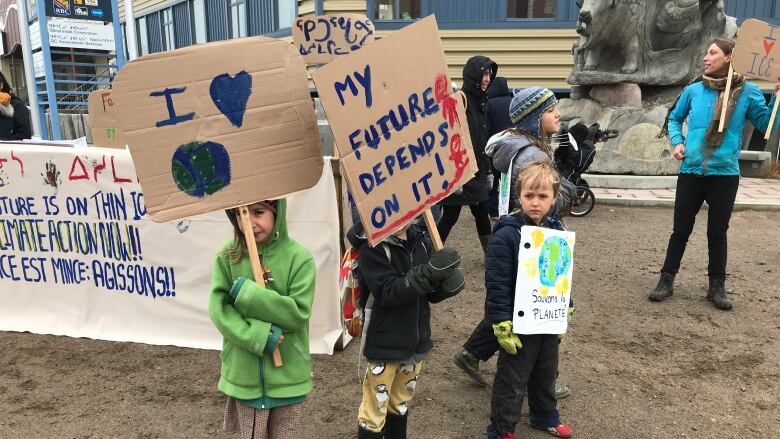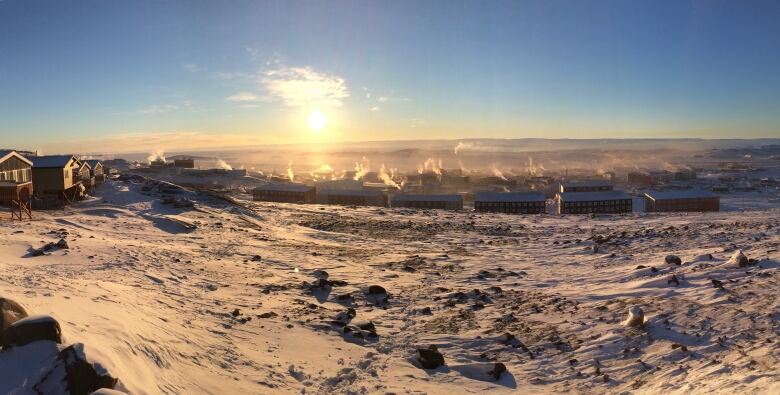Nunavut and climate change: A federal election explainer
The carbon tax does not apply to everything in Nunavut, but its still increasing the cost of living

Nunavut is feeling the effects of climate changemore than the rest of Canada,and all four candidates in the upcoming federal election are talking about the issue.
From 1948 to 2016, Nunavut saw average temperatures increase by 2.7 C, whereas Canada as a whole saw a change of 1.7 C, according to Environment and Climate Change Canada.
At the national level, climate discussion has focused on pipelines, planting trees and other promises that may be hard for Nunavut to see itself in, but Paul Crowley, WWF-Canada Arctic's vice-president, says Nunavummiut should still be paying attention.
"Climate change is impacting us the most. Communities that have historically put very little emissions up into the air are getting all of the impacts and having to adapt," Crowley said.
Last week, more than 120 Iqalummiut took part in marches scheduled throughout the day to coincide with the global climate strike.
Kivalliqhydro-fibre link
Nunavut's Conservative candidate, Leona Aglukkaq, said to address the territory's dependence on diesel all 25 communities are powered by diesel generators a Conservative government would work with organizations like the Kivalliq Inuit Association (KIA).
KIA is proposing a 1,200-kilometre link to the Kivalliqregion from Manitoba, with an expected cost of $1.2 billion. It would power five communities and two mines, cost Qulliq Energy Corporation50 per cent less than diesel-generated power and reduceair pollution and the risk of fuel spills.
The Liberal government funded a feasibility study of the project, at a cost of $1.6 million, in February.
"One of [the Liberals'] bigger priorities too is to address climate change by taking real action," said Liberal candidate Megan Pizzo Lyall.
"We believe in paying for our pollution," Pizzo-Lyall said. "Inuit have been known to be the canary in the mine shaft ... we faced them ... the strongest impacts, and we want to see the improvements."
NDP candidate Mumilaaq Qaqqaq agrees.
"Part of our platform is having Inuit in leadership positions at decision making tables at a very high level to direct climate change efforts in the country, as well as increasing protected water and land to 30 per cent across Canada," Qaqqaq said.

Green candidate Douglas Roy advocated for shifting to renewable energy across Canada.The federal Green party platform also promises to fund proper solid waste management systems inArctic communities by 2021.
- OPINION | Liberals' climate balancing act: The world is watching
- OPINION | Greens' climate plan adds up to Mission: Improbable
What's produced from Nunavut's sewage lagoons is diluted in the ocean, but it contains what's produced by businesses and the drugs residents take, Crowley said.
"We can't continue ... crapping in our own beds," he said.
The carbon tax
This federal election will also be a referendum on the carbon tax, which aimsto reduce greenhouse gas emissions.The Conservatives have pledged to repeal it, if elected.
"A carbon tax does nothing to address the environment we are living in,"Aglukkaq said.
"When you go to the grocery store, when you buy your gasoline to go hunting, to heat your home, and so on ... you're paying for that."
But Crowley said the carbon tax is "the most efficient way to move people to use less greenhouse gas emitting fuels, and we need to do our part in Nunavut."
The carbon tax came into effect in Nunavut on July 1. However, the territory negotiated certain exemptions so thatNunavummiut do not pay more for electricity or air travel because of the tax.
Home heating fuel and gasoline are not exempt, meaning the costsfor those have gone up.
It costs $60 more to buy 250 gallons (946 litres) of home heating oil and about $2.80 more to fill up a 60-litre tank of gas, according to a Nunavut government fact sheet on the carbon tax.
- OPINION | Conservative climate plan is cloaked in mystery, choked with irony
- OPINION | NDP climate plan tries (and fails) to carve out middle ground
For items shipped via NEAS sealift, starting next sealift season, 100 per cent of the carbon tax on shipping fuelwill be passed on to customers, NEAS president Suzanne Paquin said.
The Nunavut government has introduced a rebate that effectively cuts the tax's impact on fuel purchases in half. It also plans to amend its Income Tax Act to offer further relief.

The Liberals' plan is to slowly increase the tax rate until 2022, and the territorial rebate will increase along with it to continue to reduce the tax by half.
The rebate is not forever it's just designed to giveNunavummiutmore time to adjust and find ways to reduce their emissions as options are fewer in the North, according to Nunavut's finance minister GeorgeHickes.
Nunavut gets back all the money collected from the carbon tax, which it is currently using for the rebate, butas the tax increases, it will look for other uses for the money.
When in full effect the federal government estimates a family in Nunavut could pay $1,100 more than it is now though families that don't pay for heating will pay less.
"Nunavummiutwho use more fuel will pay more carbon tax," the fact sheet said.
Contributing to climate change
Of all the provinces and territories, Nunavut produces the second-smallest amount of greenhouses gases in Canada. In 2017, it produced the equivalent of 0.6 megatonnes of carbon dioxide.
For comparison, Yukon produced 0.5 megatonnes and Alberta the highest emitter produced 272.8 megatonnes, according to Statistics Canada.
NunavutPremier Joe Savikataaq says the territory needs to focus on mitigation because it's not a big emitter.
All parties have pitched retrofitting homes, to make them more energy efficient, as one way to address climate change. The Conservatives would offer a 20 per cent tax credit on renovations, whilethe Greens promise to make every building in Canada carbon-neutral by 2030.
WWF-Canada released a report last month that found switching to renewable energy in communities like Iqaluit and Rankin Inlet, would be feasible with subsidized loans or grants. It would like to see those commitments from the parties.












_(720p).jpg)


 OFFICIAL HD MUSIC VIDEO.jpg)
.jpg)



























































































